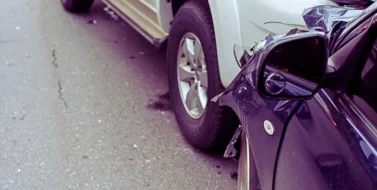Is an uninsured driver automatically at fault after a car accident? In Illinois, liability in a car accident is assessed based on comparative negligence, not the driver’s insurance status. This implies that the driver who is primarily responsible for the accident must compensate the victims, irrespective of whether they have insurance.

For guidance on how to seek damages after an accident involving an uninsured driver, reach out to the car accident lawyers at Lloyd Miller Law Group at 773-838-8100 for assistance.
Table of Contents
Fault in Illinois Car Accidents Involving Uninsured Drivers
In Illinois, fault in a car accident is based on comparative negligence rather than insurance status. The driver found most at fault must compensate the victims, regardless of coverage.
What Is Fault?
In legal terms, fault pertains to the level of blame or accountability assigned to a person for causing harm or damage. When a person is deemed at fault, it indicates they are responsible for an accident. This could involve behaviors such as reckless driving, breaching safety regulations, or engaging in deliberately harmful actions. For instance, fault may include causing a vehicle accident due to distracted driving.
In civil lawsuits, the party at fault might be required to compensate the injured party for their losses. This compensation could cover expenses like medical bills, property repairs, or other damages arising from the accident.
Fault and Insurance Coverage
If the individual at fault has insurance, their policy typically covers their liability by compensating for the damages the victim has suffered and is legally entitled to claim. However, if the at-fault party lacks insurance, they will need to cover the expenses resulting from the accident out of their own funds. While insurance is crucial in determining where a victim can seek compensation, the issue of fault is distinct and involves identifying who is responsible for the accident. Understanding the ins and outs of insurance is vital, as it influences how you pursue compensation for your damages following an accident involving uninsured driver fault in Illinois.
What Is Auto Insurance?
Auto insurance helps protect you from financial loss by requiring you to pay a monthly premium in exchange for coverage against damages or injuries. If you cause an accident and the damages total $16,000, without insurance, you would need to pay this amount out of pocket. However, with an insurance policy that has policy limits of up to $20,000, your insurer would pay for the repairs, alleviating your financial burden.
There are two types of claims: first-party claims are made to your own insurer, while third-party claims are filed against the other driver’s insurance. In Illinois, drivers must have at least $25,000 in liability coverage for one person and $50,000 for multiple victims, along with $20,000 for property damage. Proof of insurance is required biannually, and failing to maintain coverage can lead to fines. Although car registration requires proof of insurance, drivers can cancel their coverage soon after, leading to over 16% of them driving uninsured in Illinois in 2022.
What Are Your Options for Seeking Compensation After an Accident Involving an Uninsured Driver?
When an uninsured driver hits you, securing compensation for your injuries can be challenging. Nevertheless, there are several options you can explore.
File a Lawsuit
You have the option to file a lawsuit against the driver who caused the accident and seek compensation from their personal assets. However, it’s possible that the driver may not have enough funds to pay you, and pursuing legal action could be a lengthy process. The court might need to place a lien on their property or garnish their wages in order to assist you in receiving your compensation.
File an Insurance Claim Under Your Uninsured/Underinsured Coverage
If you have uninsured motorist coverage through your insurance provider, you can receive compensation from them if you’re involved in an accident caused by an uninsured driver. Your insurance will cover your losses up to the limits outlined in your policy.
Even if the other driver is responsible for the accident and doesn’t have insurance, you can file a claim with your own policy using uninsured or underinsured motorist coverage. This can be beneficial since it allows you to avoid the complications of seeking compensation directly from the at-fault driver. Typically, pursuing a claim against an uninsured driver can be challenging, as they likely don’t have the financial means to cover your damages. There is a difference between uninsured and underinsured in an accident. If the driver at fault has insurance coverage, but it is insufficient and can’t fully compensate for your losses, your underinsured motorist coverage can help make up the difference.
Uninsured Coverage
If you are involved in an accident with a driver who is at fault but lacks insurance, uninsured motorist coverage can provide financial protection, and knowing how to file an uninsured motorist claim may be important. This type of coverage compensates you as if the other driver had liability insurance and is classified as a first-party claim, meaning you’ll file it with your own insurance provider.
In Illinois, uninsured motorist coverage is mandatory, and the minimum limits align with those set for liability insurance. You must maintain uninsured motorist coverage with at least $20,000 for an individual injury per accident and $50,000 for injuries to two or more people in one accident. While you are not obligated to obtain coverage for property damage, your insurer may offer it as an option, albeit at a higher monthly premium.
Underinsured Coverage
If you’re involved in an accident caused by another driver who is at fault and their insurance coverage is insufficient to cover your medical expenses, underinsured motorist coverage can come to your aid. This type of coverage will pay the difference between the at-fault driver’s insurance limits and your medical bills up to the maximum limit of your policy. In Illinois, underinsured motorist coverage is required, with minimum coverage of $25,000 for injuries to one person and $50,000 for injuries to two or more people per accident, mirroring the requirements for uninsured motorist coverage.
For example, you may be in an accident that results in $40,000 in medical expenses. If the at-fault driver has insurance coverage of $25,000, and you possess underinsured motorist coverage of $40,000, the other driver’s insurance will pay the full $25,000 their policy allows to help with your medical bills. This would leave a $15,000 gap, which your insurance will pay under your underinsured motorist coverage.
To qualify for underinsured motorist coverage, two criteria must be met. First, the owner or driver of the other vehicle must be at fault. Second, their insurance liability limits must be lower than your own underinsured motorist limits. Additionally, your injuries must have been caused by the underinsured vehicle to file a claim. If the at-fault driver’s liability limits match those of your policy, you will not be able to make an underinsured motorist claim.
How Fault Is Determined When the Other Driver Is Uninsured
In car accident claims and personal injury cases, demonstrating fault involves proving that the responsible individual acted with negligence, regardless of their insurance status. If you were negligent in a car accident, you are deemed at fault. Determining fault in uninsured driver accidents requires you to demonstrate four essential elements:
Duty of Care
The duty of care exists when there is a relationship between the parties that obligates the defendant to take actions to avoid causing harm to the plaintiff. In the context of a car accident, this duty is typically always applicable, as all drivers have a legal responsibility to exercise appropriate care and caution towards other drivers, passengers, motorcyclists, bicyclists, and pedestrians.
Breach of Duty
A person is considered to have violated the duty by not acting with reasonable caution, given the situation. For instance, a driver may breach this duty by exceeding speed limits, ignoring stop signs, driving distracted, or operating a vehicle under the influence.
The Driver’s Negligent Conduct Caused the Accident
To determine fault, it’s essential to demonstrate that the actions of the other driver led to the accident. For example, if the incident was caused by an oil spill on the roadway, the driver would not be held responsible. Conversely, if the accident resulted from the other driver’s reckless behavior, they would be considered at fault. A review of the evidence and circumstances surrounding the accident will reveal the causes of the collision.
Damages
You must demonstrate that you have experienced harm due to the accident. This harm can manifest as physical injuries or property damage. Simply proving that the other driver did not act with reasonable care is insufficient; you need to establish that the negligence directly resulted in actual damages for you. If you haven’t incurred damages, you cannot file a claim. Damages may be categorized as economic, such as medical costs and lost wages, or non-economic, which includes emotional distress and pain and suffering.
Comparative Negligence
Typically, no single party is entirely to blame for an incident, and both may share some degree of responsibility. In such instances, comparative negligence comes into play to allocate fault.
Illinois employs a modified comparative negligence approach for recovering damages. Under this system, the compensation amount you receive will be reduced in proportion to the percentage of fault attributed to you. If you are found to be equally at fault or more responsible for the incident, you will not be eligible for compensation. To qualify for damages, your level of fault must be less than 50%.
For instance, if you are making a left turn at an intersection without exercising adequate caution while the other driver is speeding, leading to a collision resulting in personal injury and property damage, both parties have neglected their duty of care and share some responsibility. The speeding of the other driver contributes to the accident, while you should have been more careful before making the turn.
If you pursue a personal injury claim against the other driver for damages amounting to $50,000, and a jury determines that your negligence contributed to the accident by 20%, while the other driver’s negligence accounted for 80%, you would only be able to recover $40,000, which is the original $50,000 reduced by your 20% fault.
Why You Should Consult an Illinois Car Accident Lawyer
Handling an uninsured motorist claim can be quite difficult, particularly if your own insurance company challenges your damages or the limits of your coverage. An Illinois car accident lawyer can:
- Investigate the Accident: Collect evidence to demonstrate the at-fault driver’s lack of insurance and determine liability.
- Assess Your Damages: Ensure that all medical expenses, lost income, and pain and suffering are considered.
- Negotiate With Your Insurer: Represent your interests to achieve a fair settlement.
- Pursue Arbitration or Litigation: If needed, car accident attorneys can advocate for you in arbitration or court to settle disputes.
An Illinois uninsured motorist attorney can assist you in identifying available underinsured motorist insurance coverage and ensure that you file your claim against the insurance company promptly, adhering to the regulations for uninsured motorist claims and the coverage terms of your policy. Uninsured motorist claims can create a conflict of interest between you and your insurer. Given the intricacies of such proceedings, it’s advisable to seek help from an attorney with experience in Illinois uninsured motorist claims. If you opt to seek compensation from the at-fault driver, your attorney can guide you in filing a lawsuit and exploring ways to recover your damages from that driver.
Having an attorney maximizes your chances of successfully recouping compensation. If you need assistance filing an uninsured motorist claim or pursuing legal action, contact us at Lloyd Miller Law Group for underinsured motorist accident lawyers who can evaluate your case and help you identify the correct avenue for pursuing compensation.





